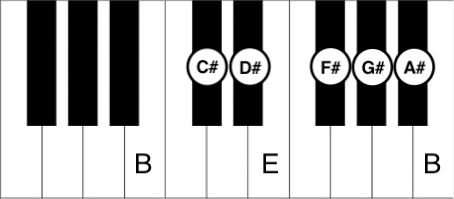Learning scales is one of the best ways to build technique and confidence at the piano. Today, we’ll walk step-by-step through how to play the B Major Scale, using proper fingerings in both the right and left hands. Once you’ve got it down, you’ll notice how smooth and natural it feels to play.
Notes in the B Major Scale
The B Major Scale is made up of the following notes:
B – C# – D# – E – F# – G# – A# – B
This scale follows the pattern of whole and half steps that every major scale uses, but it includes five sharps: C#, D#, F#, G#, and A#.

Right Hand Fingering
Here’s how to play the B Major Scale with your right hand:
- Start with your thumb on B, pointer on C#, and middle finger on D#.
- Next, tuck your thumb under to play E.
- Continue with F# (pointer), G# (middle), A# (ring finger), and B (pinky).
On the way back down:
- Play down to E with your thumb.
- Cross your middle finger over to D#, then C# with your pointer.
- Finally, land back on B with your thumb.
This crossing under and over technique keeps your hand position comfortable while moving through the scale.
Left Hand Fingering
The left hand works a little differently than the right:
- Begin with your ring finger (4th finger) on B.
- Play B – C# – D# – E using your 4th, 3rd, 2nd, and thumb.
- Shift your ring finger over to F#, then play G# with your middle finger, A# with your pointer, and B with your thumb.
On the way back down:
- Play from B to E.
- Cross your thumb under to E, then continue with D#, C#, and finally land back on B with your ring finger.
Hands Together
When playing hands together, notice these key points:
- Start with your right hand thumb and left hand ring finger both on B.
- As you climb the scale, both thumbs will land together on E—this is a helpful landmark to remember.
- Continue through the remaining notes until both hands land on B at the top.
- Coming back down, your thumbs meet again on E before finishing the scale.
Final Tips
The B Major Scale may look intimidating with all its sharps, but with the right fingering it actually feels smooth under your hands. Practice slowly at first, focusing on crossing your fingers at the right times. Gradually increase your speed as it becomes more natural.
Mastering the B Major Scale will not only help you strengthen your technique but also prepare you for playing music written in sharp keys. Learn more major scales from our online tutorials.




